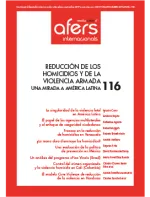The effect of controlling organised crime on homicidal violence in Cali (Colombia)

Since 1993, when the System of Surveillance of Deaths of External Causes (SVMCE, in its Spanish acronym) was established – today the Security Observatory – a reliable record of homicides has existed in Cali which has allowed the control of organised crime to be evaluated as a strategy for reducing homicides. This strategy has been based on the pursuit and prosecution of urban criminal gangs, placing emphasis on intelligence and investigation, as well as coordination between the Police and the justice system. Drug trafficking allowed urban criminal gangs to develop that have had a significant effect on the homicides in Cali and other cities in Colombia. This paper evaluates the impact of the fight against criminal gangs implemented across the whole city of Cali from 2013 to 2015. The deactivation of several criminal gangs and the reduction in the overall homicide rate in the city have brought positive results, above all in the category of “organised crime”, but also to some extent in “common crime”.
Key words: Cali, Colombia, urban crime, homicide, Police, justice, drugs, violence
Andrés Fandiño-Losada. Instituto Cisalva y Escuela de Salud Pública, Universidad del Valle, Cali (Colombia).
Rodrigo Guerrero-Velasco. Instituto Cisalva, Universidad del Valle y exalcalde de Cali.
Jorge H. Mena-Muñoz. Instituto Cisalva, Universidad del Valle, Cali.
María Isabel Gutiérrez-Martínez. Instituto Cisalva y Escuela de Salud Pública, Universidad del Valle, Cali.
DOI: doi.org/10.24241/rcai.2017.116.2.159
>> The full text articles of this issue are available only in Spanish language